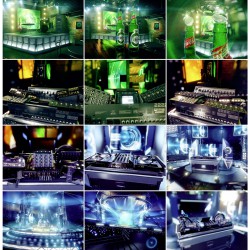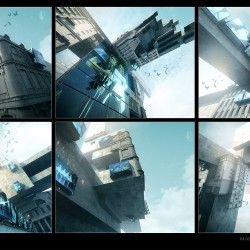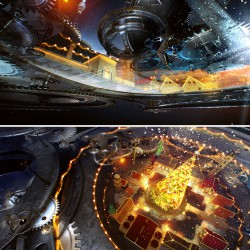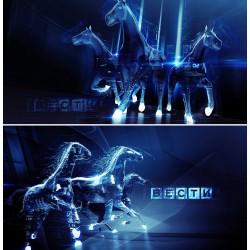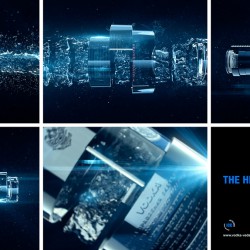
This month we talk with Timofei Penkov production director of N3.
Timofei, could you tell me a little bit about the history of your company?
The company is more than 6 years old. At present, we are one of the leading post-production companies in Russia. We specialize in the production of graphic elements for TV channels and computer-generated imagery for advertising spots. We very rarely work with special effects for cinema, although this is always a possibility for us. When it comes to CGI, we prefer motion-design for TV and complex advertising projects the most.Andrei Golikov, who has worked at N3 since its foundation, is the head of the company.
What projects have you worked on lately, and what are you working on now?
Right now we are producing four elaborate advertising spots and one full-HD broadcast for NTV+’s stereo-channel. Before that, we made a few ads and on-air packages for such TV-channels as Rossiya-2, DTV, and REN, the design for TV-programmes on the Russian Channel 5, Rossiya, and a few others. Even before I joined it, and certainly after, the company was working with, I think, all the leading TV-channels in Russia.
When and on what kind of projects did you begin to use Cerebro?
We started using Cerebro about a year ago. It took a while to get used to it, but in the end I prevailed and now we use the software a lot. We switched to the local version, because we were too dependent on the Internet connection, its speed and so on, and when you are using something a lot, such limitations are difficult to live with. So, it’s been about a year since we’ve started putting all imaginable tasks that need to be done to complete a project in Cerebro.
What helped you get used to Cerebro?
For me, the moment you know that a piece of software has caught on is when everyone knows where to look for things. It’s been a while since anyone has asked: ‘Where’s this file or the other?’ It’s always in Cerebro, attached to your task.
As a manager, which functions of Cerebro do you use the most?
We don’t use budgeting in Cerebro, because the reality of the market is such that the budget is decided long before the project starts, and the final budget is confirmed basically during the bidding process. By the time the project begins to be fleshed out, all the budgets have been fixed upon and there are no financial discussions. But I’m absolutely sure that if a company, say, only works with freelance designers, this function could be extremely useful for the head of that company. They would probably have an hourly rate of some kind, and they could calculate and analyze the invoice for the whole project at once. We use Cerebro for the dailies and as a database. All comments, all dailies, and every time we send something off is recorded there, which can be very helpful during discussions with the client.
Do you use the Gant diagram? Or do you use something else for scheduling?
Yes, we use it. We used it a lot at first. However, because it doesn’t always stack up to reality, we tend to use it for larger projects now, which last more than three weeks. For us, the Gant diagram is a planning tool, when we need to see, where things overlap. But I would also like to be able to use colour-coded tags, as it would be easier for me to look at the colour and see whether the status is ‘I’ve sent off the materials, awaiting reply’ or ‘There has been a reply’.
Do you use the drawing function, text comments, audio comments?
We use text comments all the time, we’ve made it our standard policy. If something isn’t in Cerebro, it’s as if it never existed, especially in discussions with clients. For example, instructions over the phone may be heard, but not carries out. This is why we always have text comments. Everyone needs them – both the person who is told to do something, and the manager who tells them to do it. We haven’t really been using the drawing and audio functions, because we have an open-space office and don’t have any one working from home, so if something needs to be discussed, we can do it at the office. The art-director, when we are discussing a project, tells everyone how they see each task and the clip as a whole. Then, when people get actual instructions, they sit down together with the art-director, who explains exactly what he wants from them. Because we can have a lot of tasks, and most of them are quite small and short, we usually don’t need any further comments in terms of execution. This can happen with large cinema projects, but we don’t use it.
Are you getting more sleep now that you’re using Cerebro?
Well, I’ll never get enough sleep, but there’s no feeling of chaos now. This is what Cerebro is for, it helps to get rid of information overload. Now everyone knows, where everything is. Everyone knows, what they need to do, everyone knows where to look for information, everyone knows, where to put things. And this is about one-third of the task as a whole. Before we had Cerebro, there were these folders ‘In’, ‘Out’, ‘Mail’, ‘Complete’, ‘Complete 2’, no-one knew where to find anything. Now all the dailies and the complete clips are in Cerebro, and it’s a lot easier to work with information.
Which Cerebro client are you using? Mac OS, Windows, Linux, Web-based or maybe the iPhone app?
All the designers are using the Microsoft Windows version, and most of them don’t need anything else, they don’t even use Cerebro at home. There are a few guys who love to work so much that they’ve installed Cerebro on their computers at home. People come to the office in the morning and say: ‘Oh, hey, a comment, great!’ The pop-up notifications are working great for us. Personally, I use Cerebro all the time, I’ve installed it everywhere – on my iPad, on my iPhone, on my Macbook, on the computer at work… But I’ve customized everything, so that I can use PPM to comment something on the iPad or upload it, and so on. By the way, on the iPad the images look bolder and, let’s say, prettier. It would be great if you could write messages when you are offline, and then sync them with the database.
Yes, we are working on that at the moment. And we will add these functions to the main Cerebro version as well, so that you can edit, comment, and create items on your laptop without an Internet connection. What else would you like to see in Cerebro? Do you find the interface usable?
At first, everyone hated the interface, as we have a company-full of creative types, they all criticised it, said it was unusual and hard to use. Mostly people use the navigator with the lights, nothing else. I don’t have any real problems with it. There are a few little annoyances, for example, how you need to always enter numbers when you name tasks, so that they are sorted by name, which is quite inconvenient.
Yes, we are working on a sorting function with arrows up or down.
That would be useful.
Are there any other programs that you think should be integrated with Cerebro workflow?
You should just make it possible to improve Cerebro with a SDK and to export data to other applications.
Yes, we’ll release a SDK soon, which will make all of this possible.
Thank you for answering my questions.
Other works on – http://www.n3workshop.com
